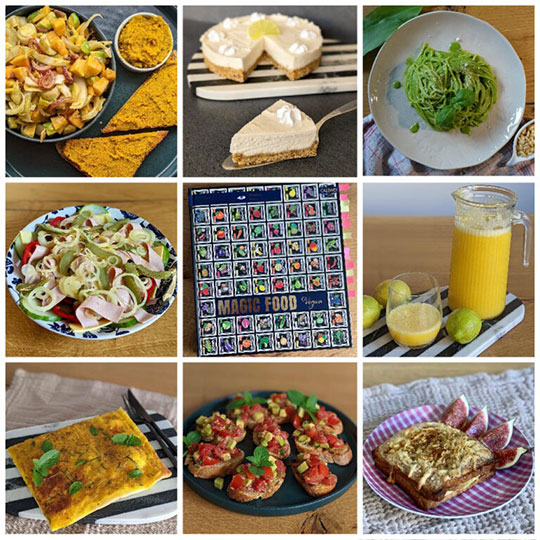
„Magic Food: Vegan“
By:
Franziska Gräfin Fugger von Babenhausen & Mauro Bergonzoli

hardback | number of pages: 208 | publisher: Callwey | language : German (only) | publishing year: 2021 | ISBN-10: 3766725513 | ISBN-13: 978-3766725516
Who wrote it?
Franziska Countess Fugger von Babenhausen and her husband, the artist Maestro Mauro Bergonzoli are the brains behind this extraordinary cookbook. If you haven’t heard of them, like I did before owning this book, you can find out more about the creative duo on the blog TheMagicContessa.com as well as on Mauro’s website MauroBergonzoli.com.
And what is it about?
The Countess and the painter came to experiment with plant-based nutrition after Mauro had a heart attack. The treatment following the incident gets the passionate artist’s heart pumping again, but the many pills are not without side effects: “His skin turned greenish, his eyeballs yellow, he became more and more weak and unhappy. He even lost interest in painting.”
From then on, Countess Franziska cooked for her husband with vegetables from their own garden, gluten-free pasta, coconut milk and cheese without animal ingredients, and it wasn’t just his blood values that improved noticeably. In this book, the couple shares the recipes with the “Magic Food” ingredients with the world.
What does it look like?
The look of this total work of art is definitely to be emphasized. Starting with Mauro’s illustrations of each of the ‘Magic Food’ ingredients gracing the front and back, to the bold but always stylish photographs accompanying each recipe, to the lavish, multi-colored layout of the recipe pages. Incidentally, the generosity is made possible by the lavish format of approx. 26 x 28cm. In my opinion, the entire creation is a coherent coffee table book that not only looks good on the bookshelf.
What can I expect?
The book contains 77 recipes, divided into the following chapters: “Breakfast & Brunch”, “Soup & Salad”, “Pasta, Risotto & Co.”, “Sweet & Gelato”.
In addition, in the foreword, Countess Franziska tells the story of how the “magic recipes” came about. Following the recipes, the book contains the “health dictionary” that lists the “magic food” ingredients individually with their health benefits and possible uses. This part is illustrated with the illustrations by Mauro Bergonzoli known from the cover.
Can I do that?
The difficulty of the recipes isn’t explicitly mentioned, but I’d say most of the recipes are easy to medium at best.
What do I need?
The book does indeed provide a comprehensive and explicit list of the 30+ “Magic Tools” in the kitchen needed for 1:1 copy-cooking/baking of any recipe, but with a well-stocked kitchen there is no need to worry about first needing to make an extensive shopping trip. You’d much rather need that for the ingredients if you don’t have Prosecco, Dijon mustard and vegan Parmesan in the house as standard. Other popular ingredients of the Countess, which at least I always have in stock, are e.g., B. coconut milk, turmeric powder, ginger and maple syrup.
Substitute products?
Franziska and Mauro’s recipes contain cheese alternatives in many places. Since there are partnerships with for example Simply V and Meggle, the vegan substitute products of these companies are often used. In my eyes, however, the creations of the Countess go beyond veganized variants of recipes with animal products by simply exchanging them.
…ok, maybe apart from the Swiss wurst salad ;-).
Who needs it?
I explicitly advise against this book to anyone who shys away from using vegan cheese alternatives, or who wants a lot of recipes for little money. Anyone looking for recipes for balanced, healthy vegan cuisine will also certainly find more suitable titles. But if you want a creative, colorful and beautifully photographed book, in which the recipes may sometimes even take a back seat (but are no less tasty for that), you will like the book.
Oh yes, and does it taste good?
The more than 10 recipes that I have already tested have not disappointed at all. Here and there the effort was not quite in proportion to the result (e.g., with the sweet potato fries) and some recipes were also not very unusual (e.g., spaghetti aglio olio peperoncino, or spinach spaghetti). So far I have not discovered any total failures in the book.
You can find all the recipes tested and my recipe reviews on Instagram under the hashtag #VCRmagicfoodvegan.
Recipe tips to get cooking or baking:
- Fig Monsieur
- Avocado Papaya Chicory Salad (find the recipe here)
- Magic Herb Pizza
Conclusion
With “Magic Food: Vegan”, the Countess and her Maestro have created a perfect hybrid of cookbook and coffee table book. The sturdy format, the large, colorful photographs and, of course, the artistic illustrations elevate the work beyond just being a cookbook. But it is also a fact that many recipes call for substitute products and, in my opinion, the claim to supply healthy recipes is sometimes missed. In the end, everyone has to decide for themselves whether they are willing to pay the rather high price and whether they need it for their own cookbook collection.